|
Travels of the "Leah Gent"
by Brad Indicott
Note: This beautiful boat is for sale. Click HERE for info.
Our search for a boat began right here on the Duckworks site. I had looked the internet over for a design that would be a good choice for a coastal cruiser. I bought a set of plans from Phil Bolger for his Windermere design but didn't find the boat a good fit for us. Then our world changed. Mark Van Abbema was putting together a 39' Sharpie that only needed 11" to float and promised good speed with low horsepower. My wife, Debbie, and I were hooked! Well at least I was. We waited and watched Mark thru his web site, Markvdesigns.com, build his boat. It looked easy enough and I kept pestering Mark for a set of plans. Finally in April of 2002 the plans were ready and a trip to Ft. Myers Beach (Mark's winter home) to pick them up was arranged. It's about 800 miles from our home in the North Carolina mountains to Ft. Myers Beach but we were on on a mission. Mark took us by dingy out to his boat in the harbor (on the sand bar) and I was impressed by the good lines and ample headroom he had designed. I had lots of questions but Mark seemed to be in a hurry. I learned years later that he had thought we were the ones in a hurry and he felt bad about holding us up from getting home. He really is passionate about boats. So home we went with our dream design in our hands.
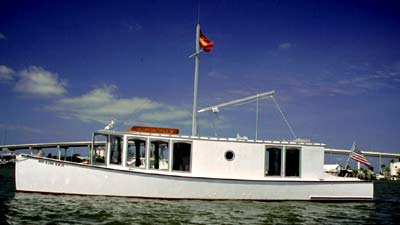
Mark's boat: the 'Heart of Gold II'
We informed our friends and family that I was going to not only build a boat, a 39' boat, and then cruise the entire east coast of the US from end to end. Reactions ranged from "Yeah, right" to "Will it float?" I don't think anyone actually thought I could do it. Enter the internet, again. " It's all on the internet" I told them. Indeed, every question about boatbuilding is answered some where on the internet. You just need to start at the Duckworks page and follow the links and boatbuilding forums for the answers.
The stongback and frames went together in late April. Our local Lowe's had just opened one of their superstores and as they were stocking the shelves they took delivery of a stack of 3/4" Marine fir plywood that was supposed to have been shipped to a coastal store. The local contractors didn't want to pay the price and I had told the guys in contractor sales about my boat idea so they called me and later that day I was the proud owner of 33 sheets of plywood at 30 bucks a sheet. Now we HAD to build a boat.
The planking went well and the hull was turned over in about 6 weeks. I changed Mark's plans from 1" sides and 2" bottom to 3/4" sides and 1 1/2" on the bottom and it's worked out fine. Debbie would look at the plans and then ask questions and my standard answer was always "You'll see". My contractor friends who I have a great admiration for would only scratch their heads and tell me they could never build a boat but they didn't seem to have problems with building a 5,000 square foot home. I never figured that out.
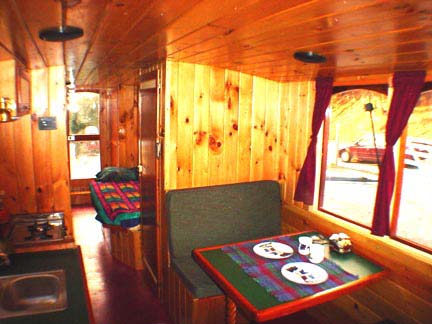
The first winter allowed us to get the interior, cabinets and water systems installed. Because we had a low ceiling with all the plastic sheeting up to keep the cold out I put the roof on last. The next summer was spent painting, sanding, sanding, and more sanding. The knotty wood interior was installed after all the wiring was in. If there is one thing that I was most surprised about it was the amount of wire in a boat. Of course I went way over on my wire sizes according to a Navy electrician that later helped me connect it all to the panels but I have never worried about the wires getting warm. Another winter was spent taking care of more details and dreaming of our soon to be true east coast cruise. The warm of Spring brought the final expense of the 60 hp Mercury outboard motor. The motor is the single biggest expense of boat building. I'm still surprised that the Mercury cost half the price of a new Honda car! I went with the Mercury instead of Yamaha because of the larger alternator and fuel injection. I'm glad I did because the fuel injection never requires pumping the ball before starting as the carbureted engines do and the extra amps helps keep the batteries up.
In deciding a name for the boat, I had told my wife that I hoped to name it after my Grandmother. Debbie wondered why I choose my Grandmother instead of her's. After explaining that my Grandfather had put the whole family in his boat in 1941 and taken the ICW south to Ft. Lauderdale, Florida from Cleveland, Ohio she agreed to name the boat the "Leah Gent". My Grandmother passed away when I was a child and we never got to do much together but I think she would get a kick out of my adventures. Maybe it's genetic!
Almost 2 years to the day we received the plans we launched the "Leah Gent" in Oriental,NC. The trip from the boat shed to the coast is 340 miles, downhill. At the launching, Alan Arnfast, the owner of the yard claimed he had never seen so many people at a launching at his yard before. About 25 people showed up to see if the boat would float. Most from hundreds of miles away.
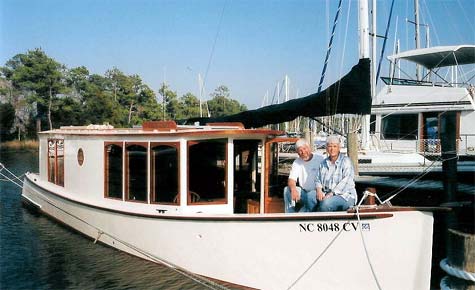
It floats! This is a great day.
The boat went in the water and floated right on her lines. Relief!! I backed her out of the slipway and headed for my own slip around the corner. Arriving at my slip at a slow 4-5 knots, I hit reverse and surprise....we were still making 4-5 knots. Seems that when I rigged the motor as Mercury suggested, I didn't take into account that the stern is only in the water 3 inches. The motor continued to cavitate as we headed down the canal and towards a very large sailboat that had backed out of it's slip, blocking our way. I finally got her stopped just short of the sailboat and proceeded slowly back to the slip. Off to the yard for a piece of 1/8th inch aluminum plate to make a bigger cavitation plate for the motor. The second trip was better but still not perfect, so back to the yard to be hauled out. I cut the top of the transom 3 inches and decided to put in a bow thruster while I was at it. I'm happy to report the boat stops, backs and maneuvers just fine.
THE BIG TRIP
We decided we needed a theme for our big trip and we found it my Grandfather's log, written some 64 years ago. He had taken photographs of the east coast at the time of his trip in 1941 and with his log in hand we set out to create at log of our own with photos taken in exactly the places where we could still find them. The waterway and towns along the way have changed but some still look the way they did in 1941 and we have pictures to prove it. We have had many a fine conversation with historians along the way. It was really strange to stand in exactly some of the same places my Grandfather had once posed for pictures.
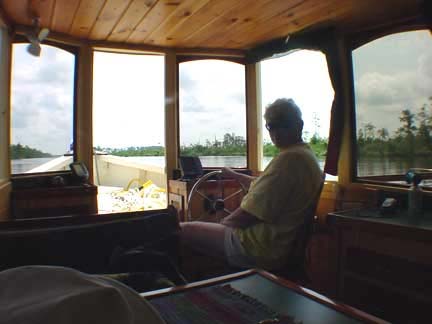
Captain Debbie in the Pungo River Canal
After putting a whopping 50 miles on the GPS around Oriental, we put the house away for a year, sold Debbie's car, said our good byes and set out to explore the east coast. Mark had told me that Sharpies are known to pound in a head sea and I was curious to see just how bad it would be. We planned to stay in protected water, but the weather has a way of changing the best of plans. We found that it rarely pounded and then it was generally in big seas on the nose. Downwind or just off the wind the boat does great. In less than 20 knots of wind, we go wherever we want. At 39' we tend to sit on several waves at the same time and there is no pounding in the short chop that seems to bother other boats. Back to the trip.....We wanted to stop at Waterside Landing in Norfolk, VA but we forgot about the big festival they have in June,so we stayed across the harbor in Portsmouth. From there we headed up the Chesapeake Bay with stops at Hampton, Riedsville, Deltaville, Urbana, and Solomons Island. Next it was a trip across the Bay to Oxford, Kent Narrows, Rock Hall and Chesapeake City. A quick note here: I had originally built the boat because I liked the lines of this design. I hadn't realized that everyone else we met along the way would be as admiring as they were. After talking with our kids one night, Debbie mentioned to them that she "wished I had a nickel for everyone who tells us they like the boat" as the old adage goes. This started our "nickel" jar. As of this writing there is way over a thousand nickels in the jar! No one ever told me they liked the Bayliner I use to have. Owning a unique boat invites a lot of attention and we have given over 500 people tours of the "Leah Gent".
Paul Esterle emailed me and told me to contact him when we got to Chesapeake City at the top of the Bay. I invited Paul and his wife, Pat, over for a tour and found out that Paul was the Asst. Mgr at the Boat US store nearby. Pat took me to the store and I bought a 3.3 Mercury for the dingy and hauled it back in Pat's car to the boat. We had a good dinner with the two of them and headed up the C&D canal for Delaware Bay the next day. Paul later wrote a big piece about us for Nor'Easter magazine. Although the scenery along the ICW is nice, it's the people we met along the way that we enjoyed the most about the trip.
Delaware Bay was a 55 mile run from the C&D to Cape May,NJ. Luckily we had calm winds when we left Delaware City but that changed to 15 knots from the NW, a following wind. By the time we had Cape May in site we were surfing 5-6 waves straight towards the Cape May canal. We averaged over 10 knots for that trip. The boat surfs great!! It gets real quiet and the speed goes up with no tendency to veer off course. The Mark V-39 has a little rocker for and aft and twin skegs in the back which really helps it stay steady downwind. I was having a blast!!
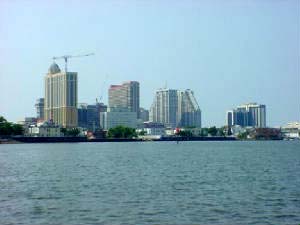
Hotels on the Atlantic City Boardwalk
The back side of New Jersey is known for it's shallow depths and most boats heading north go outside from Cape May to the New York. Seeing as we only draw 11" we did the inside route and ran aground for the first time just south of Atlantic City. It seems the markers got on the wrong side of the boat. This is still a mystery to me how this could happen. Panic set in and I told Debbie to get out the Sea Tow card for their number. As it worked out, the bottom was only fine sand and after almost breaking my leg jumping over the stern and finding out the water was only inches deep (my days of racing deep draft sailboats told my brain to expect more) I raised the motor, pushed the boat back to the channel and proceeded on. No problem!! Shallow draft does have it's advantages! A few nights in Atlantic City and I forgot all about the grounding. We left New Jersey thru Manasquan Inlet for the required 26 mile stint in the ocean up to Sandy Hook and the Hudson River. Two things went wrong. We left Manasquan inlet on the low tide and hoped to catch the incoming to flush us up the Hudson. The low tide at Manasquan idea was good except for the 5 knot current and two inbound shrimp boats with their outriggers down. Oh, there was also several BIG standing waves entering the ocean. The first one went under the boat and the second one came in thru the front door. I had that deer in the headlights look as I watched all this beautiful green water stop back around the bed. Debbie started the clean up while I closed the front door. My normal approach to big waves is to take them on an angle and everything works fine but the shrimp boats were taking up 2/3rds of an already narrow channel and there was no escape. The boat ended up fine except that I had to replace the CD player which is located next to the front door. The ocean had a nice swell and we headed north. The wind was forecast as 10-15 out of the west but was 20 knots out of the north and that turned the ocean into a mess. We arrived behind Sandy Hook wet and very tired. The Hudson would need to wait for better weather. The next morning was glassy calm and we stayed the night across from Manhattan in Liberty Landing Marina. This would be the most expensive dockage of the whole trip but oh what a view. We toured the Statue of Liberty and Ellis Island and then took the fast ferry over to Ground Zero, the spot where the Trade Towers once stood.

an old boat on the Hudson
The trip up the Hudson was very smooth. North of the George Washington Bridge there are few boats on weekdays. We passed West Point and two days later we were at the first lock north of Albany. We stopped at Waterford, the intersection of the Erie and Champlain Canals for a few days of rest. It's at this junction one must choose to head north on the Champlain Canal or west on the Erie. We choose to do the Erie first. We had cruised the Erie Canal before in chartered packet boats but had wanted to do a trip in our own boat. The Erie is totally protected with the exception of Lake Sylva. Almost all the cruising here is in a canal about the width of an interstate highway and even narrower in most all of the towns. The best thing about the Erie Canal is that the towns were established at about the distance that was equal to how far a boy and a mule could walk in a days time. About 20 miles or so. Today the canal is owned by the New York Thruway and they have put literally millions of dollars into the restoration of the locks, seawalls and towns. And it shows. Even in the years since our first cruise and this one, we can see the change. The Erie can be broken into two segments, the eastern portion starting at Waterford near Albany and ending at Lake Sylva and the western portion from Lake Sylva to Tonawanda, near Niagara Falls and Buffalo. For the small boater the western end is a better choice. The canal system requires a permit to go thru the locks and the price for our boat was $75 for one year. The great thing about the canal is that once you get your sticker, you can tie up at any of the locks and most all of the towns for free. Some towns even furnish water and electric. After a year of cruising, I can say that this is the best deal going. The Erie can be done by anyone ranging from kayaks to cruising boats approaching 60' in some cases. A lot of sailboats cruise the canal after removing their masts in order to get under several of the fixed bridges.
Some of the towns we liked best are Waterford and their Welcome Center, Sylvan Beach on the east shore of Lake Sylvan, Baldwinsville, Fairport(our favorite), Pittsford, Holley, Middleport and Tonawanda. I could fill a hard drive with all the things we did in these towns, but I'll leave it to you to take a trip there and enjoy the canal for yourself.

my first Northern Pike
We took a side trip up the Oswego Canal and had planned to cross Lake Ontario and take in the Canadian canals to Ottawa and then to Montreal and back to Lake Champlain but the big Lake had other ideas. At dinner the night before we planned to leave Oswego, we watched the waves crashing on the 12' breakwater and decided that we would rather enjoy the comfort of the New York Canal System rather than brave the conditions that a long crossing of Lake Ontario might present. We feel that all things are meant to be and this motto proved to be true as we found out the following week that Parks Canada, the folks who control the locks in Canada, went on strike and caused delays to those transiting their locks and rivers. We had already squeezed as much into our allotted time in the north as we could and a slow down would have delayed us from seeing Lake Champlain and the Champlain Canal. We backtracked to Waterford, NY and headed north on the Champlain Canal to Burlington, VT and Lake Champlain. We enjoyed the small towns along the canal and fell in love with Burlington,Vt. We had a good if not a bit windy time on Lake Champlain and found ourselves back in Waterford the first of October. We made a decision to ship the boat back to our starting point in North Carolina instead of retracing our original route north. We did 109 locks on the canals and enjoyed every one.
Back in Oriental we took time to go home and visit friends and family before heading south to Key West. The trip south is a lot more protected than going north from North Carolina. Our first stop was Beaufort, NC and it's fine NC Maritime Museum. South of Beaufort we anchored in Mile Hammock Bay, a basin dredged out by the military. We spent the afternoon watching the Marines practice moving Humvees around with their big helicopters. Noisy but an interesting place to anchor. Further south included stops at Wrightsville Beach, Southport and North Myrtle Beach. North Myrtle Beach has a free dock for 72 hours and it's a nice place to boat and people watch. Our next stop was Georgetown, SC for the wooden boat show. The Georgetown Wooden Boat show was our only "must do" of the whole trip. We entered the boat in the outboard power division and got enough votes to take home first place. This show is one of the best on the east coast. Next stop was Charleston, another great town to poke around in. Georgia with it's vast savannah's is impressive. Lots of grass and very few boats. This section of the waterway reminds me of the Mississippi River. You spend a lot of time twisting and turning only to find you have made little mileage southward.

the two boats together
Florida holds a wide variety of cruising grounds from very protected canals to wide open lagoons and bays. Because the sun is so hard on wooden boats down south there seems to be less of us there. This makes for a lot of attention directed our way when ever we get to the dock. We went south until we got to Stuart and then headed across to Florida's west coast via Lake Okeechobee. One of our goals was to show the boat to the designer, Mark Van Abbema, and maybe get a photo of the two boats together.We pulled into Ft. Myers Beach harbor and found Mark on a mooring there. He stuck his head out the window and said "nice boat". We quickly fell in tune with the local customs which involves "Happy Hour" at Bonita Bills, the local watering hole, and figured out the local public transportation. After two weeks we pushed on to the Keys, a run across Florida Bay of 45-50 miles, dodging the crab pots the whole way. After five days waiting out thirty knot winds in Boot Key Harbor it was on to Key West. A note about Key West: Anything you have ever heard about Key West is true. After spending a week and taking the obligatory pictures of us at the southern most point in the continental US (a big Buoy marks the spot) it was time to head home. We stopped at Ft. Lauderdale (where I was born and raised) for a few days and watched the truly rich come and go in their 100' plus boats, excuse me, yachts!
Fast forward to today. We are back in North Carolina and only 25 miles from our destination, Oriental, NC. We show 4500 miles on the GPS. I guess the whole point of this story is that you can still have a great time in a wooden boat, built at home and outfitted to your tastes. We never felt in danger on the trip and even after a year aboard, still sleep better than we do at home. Must be the motion. If you get a chance to do this trip, take it. The best advice we got from the other cruisers is to go while your health will still allow it. We are certainly glad we did.
Thanks to Chuck and the Duckworks pages for the inspiration. Thanks to Mark Van Abbema for a great design. We couldn't have asked for a better adventure.
You can read lots more about Brad's boat and his trip at:
https://bradsboat.tripod.com/
|

